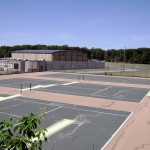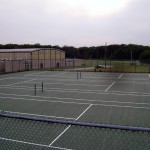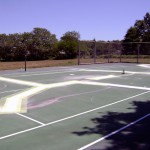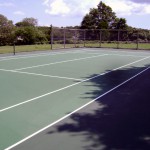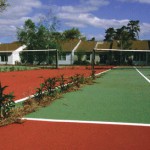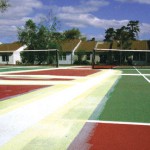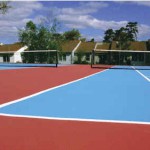Armor Crack Repair
- Installed at the site of the US Open
- Thousands of courts have ARMOR
- Successful repairs since 1993
- Effective in sub-zero temperatures
- Used on hundreds of thousands of feet of cracks
- Used in most states and many countries
- Recommended by hundreds of contractors
- U.S. Patent No. 6,450,729 B1
There is not a crack repair system in the world for tennis courts that has achieved the success rate of the
ARMOR® Crack Repair System.
It has effectively kept structural tennis court cracks from reappearing on the surface for more than five years. It has proven itself in a temperature range from below 0ºF to above 100ºF.
The ARMOR® Crack Repair System utilizes a knitted fabric that will expand as the crack widens. However, like a rubber band, this fabric will not stretch where it is glued to a hard surface. If it were simply bonded over a crack, the only part of the fabric that would be able to stretch is the portion that is spanning the opening of the crack. And, although some fabric may withstand as much as 200% expansion, the paint on top never would, resulting in the appearance of a crack. Therefore, the secret to making this fabric work is how it is purposely NOT bonded to the court in the vicinity of the crack. Thereby, allowing more of the fabric to absorb any movement or growth of the crack without the paint on top of the repair cracking.
For example: If you stretch a one-inch piece of a rubber band between your two hands, you may be able to stretch it three or four inches. But, you would be stressing it 100% of its’ capability. However, if you take a six-inch piece of a rubber band between your two hands and stretch it from six to eight inches, you would hardly be stressing it at all. Thus, the principle behind why the ARMOR® Crack Repair System works so well.
When completed, a “hollow” sound may be heard when the tennis ball bounces directly on the portion of the repair that is not bonded to the court. However, since the fabric lies directly on top of the tennis court surface, a “dead spot” is not created. The “hollow” sound is an unavoidable result of successfully repairing the cracks without the expensive alternative of completely replacing the tennis courts.
Although your tennis court is technically still cracked, that crack is isolated beneath an expandable membrane hidden from view. After this repair is covered with color coating materials, it is virtually unnoticeable. The special membrane allows the crack to expand and contract without the crack reappearing on the surface. Although it will not prevent cracks from developing elsewhere on the court or prevent cracks from growing in length out beyond the repair, it successfully keeps repaired structural cracks from reappearing on the surface.
The most common problem with asphalt tennis courts is cracking which is caused, in part, by asphalts natural tendency to shrink as it weathers and ages. In addition, asphalt loses its flexibility and becomes more brittle over time. Since outdoor courts are also exposed to weathering, including expansion and contraction caused by temperature extremes, cracking is inevitable. Asphalt tennis courts crack more quickly than asphalt roads and parking lots because tennis courts do not benefit from the compressive kneading generated by traffic which helps to keep the asphalt pliable and, thereby, delay cracking.
Premature or extensive cracking may be caused by poor asphalt mix, poor site conditions, poor design, or by poor construction. Quality design and construction may minimize or delay cracking but cannot completely eliminate it. Once cracks appear it may be impossible to repair their cause, but it is not impossible to repair the crack itself.
Including this successful new crack repair system in your estimate makes it slightly more expensive than repairing the cracks in a more conventional and ineffective manner. Most contractors simply install crack filler or put fiberglass fabric over the cracks. Almost without exception, both of these very common repair techniques will fail within one year. Whereas the ARMOR® Crack Repair System has been working successfully at keeping cracks from reappearing for more than ten years now, even in cold climate regions.




